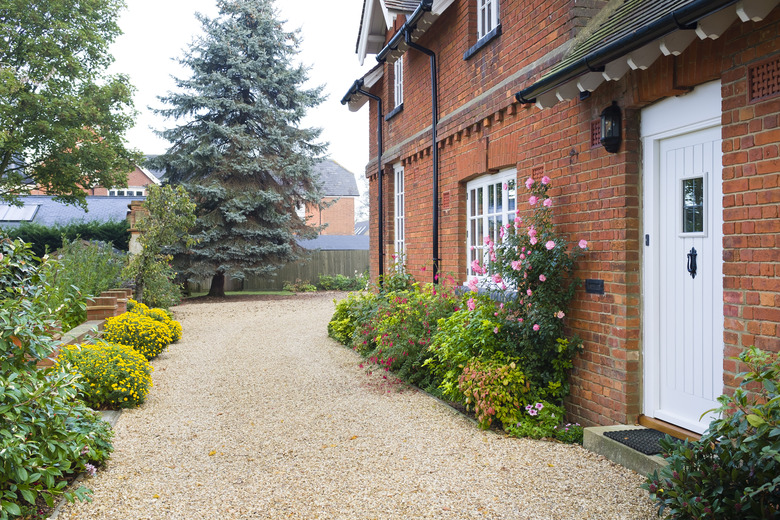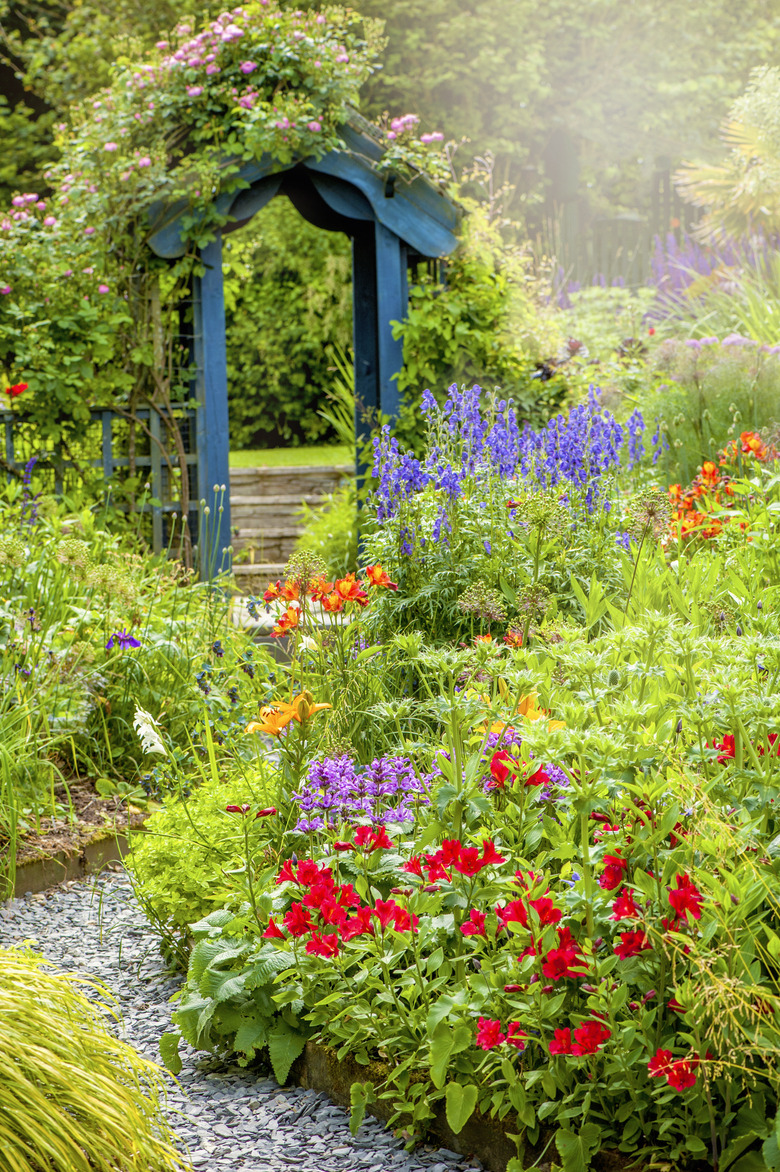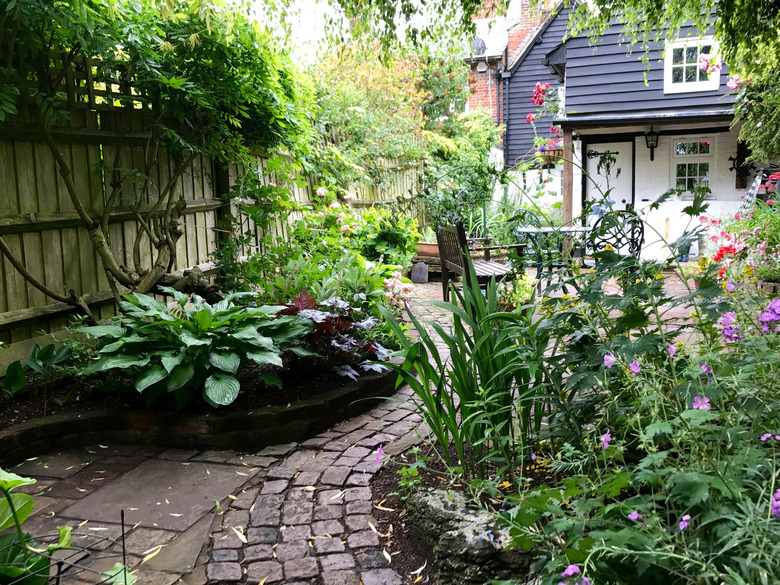How To Choose The Best Location For Your Garden
The very first step in planting a new flower or vegetable garden is deciding where to put it because the garden location determines not only what you can grow and how easy the garden will be to maintain but also the visual impact of the garden on your landscape. It's fine to place a vegetable garden out of sight, but a flower garden needs a prominent placement in full view — because what good are those stunning roses and colorful mums if no one can see them?
You might have to strike a balance between satisfying your aesthetic needs and the needs of the plants you're growing, though, because a garden with underdeveloped blooms and wilting foliage won't add much visual interest and will probably even detract. The bottom line is that you want a healthy garden, so the best location is the one that provides sufficient sun, is relatively flat and well-draining and is close to a source of water. It helps if the soil in your chosen location is fertile, but that's something you can fix with a little work and a modest investment in soil amendments.
Consider Light Requirements of Different Plants
Consider Light Requirements of Different Plants
As you ponder the placement of your garden, scan your property for the areas that receive the most sun. The best garden location for many plants is one that receives at least six hours of sun per day, but that's just a bare minimum. Many of the plants you want to grow require even more direct sunlight than that. If, however, your yard is mostly shaded, there are lots of plants you can grow in a shade garden that have colorful foliage, brilliant flowers to enliven dark nooks.
It's a good idea to start planning your garden several months to a year before you start planting so you have a chance to watch the seasonal movements of the sun. Some spots may get the minimum six hours of sunlight in the summer, and as the sun dips lower in the sky in spring and fall, it could be blocked by trees, decreasing the sun exposure significantly. That could prevent you from growing early bloomers or late-season vegetables.
If you're planning a garden next to your house or immediately adjacent to an outbuilding, the best garden location is on the south side. Failing that, choose the side that faces east to take advantage of the morning sun, and as a third option, plant on the west side to catch the afternoon sun. If you can't find a suitably sunny spot, you might want to thin some trees, or as a last resort, you can plant a container garden so you can move plants around as needed. If you're not sure how much sun your potential garden spot receives, there's a handy tool called a SunCalc that can calculate it for you.
Choose a Garden Location Near Water
Choose a Garden Location Near Water
To avoid having to run long lengths of hose from the spigot on the side of your house and having it get in the way of the lawn mower and degrade in the sun, you'll want to plant your garden near an existing spigot. If there isn't one nearby, consider installing the underground plumbing necessary to make one available. Your garden is going to need a lot of water, especially just after planting, and you don't want to depend on rainfall, which is generally too sporadic to satisfy the needs of a garden. You need an accessible water source.
If this is your first garden, you'll probably want to start with a relatively small garden plot with an area of 100 to 150 square feet so you'll be able to give all the plants the care they need while you develop your green thumb. You may go for a larger garden if you're experienced or growing vegetables that need a lot of space, such as squash.
If you're planning a large plot, consider having more than one water source available so you don't have to snake your hose through the garden to reach the other end. One way to add a spigot, assuming you don't want to install underground pipes, is to run polyethylene pipe around the garden perimeter and tie it into your existing water source. You can then tee into this pipe at any place where you need water and install a spigot there.
Look for an Airy — Not Windy — Place
Look for an Airy — Not Windy — Place
Mold and mildew on plants are two of the most destructive problems home gardeners encounter, and the most effective way to prevent them is to provide adequate air circulation. That would suggest the best garden location is one more or less out in the open — and it is — but you don't want to expose your flowers and veggies to winds strong enough to knock them over, either. If you live in an area that gets strong winds, consider locating the garden on the leeward side of a natural windbreak (the side away from the wind) that will protect it from the prevailing winds, such as a group of shrubs, a hedge or a wooden fence.
If nothing is available, you might want to consider building a small DIY fence around the garden to break the wind. Just make sure it isn't high enough to block the sun. You can use the fence to support peas and other climbing legumes, and if you make it strong enough, you might be able to use it to support squash and melons, thus saving real estate in the garden.
If the prevailing winds in your neighborhood come from the north or west, you can also take advantage of existing trees and use them as windbreaks as long as they are out of the path of the morning sun and don't provide too much shade. You can plant your garden against the south- or west-facing wall of your house or an outbuilding, which is actually a preferred location because the walls will concentrate and amplify the sunlight.
Pay Attention to Drainage
Pay Attention to Drainage
It's generally best to locate a flower or vegetable garden on flat land so that water can soak into the soil and get to the roots. If part of your yard is sloped, avoid putting the garden at the base of the slope, especially if you notice that the ground is soggy there after it rains. Most plants like well-draining soil, and their roots will rot in soggy soil. There are many exceptions, however, such as the native perennial swamp hibiscus (Hibiscus coccineus, USDA zones 5-9) that prospers on moist-to-wet soils and produces huge 6-inch red or white pinwheel-shaped flowers loved by hummingbirds and butterflies.
By the same token, you don't want your garden to be on sloping ground either, or the plants won't get enough water. If sloping ground is all you have to work with or you want to make your garden larger than the flat area you have available, consider terracing the hillside to catch water and installing an underground drainage system to prevent water from pooling in the terraces. A native wildflower garden is an exception; native wildflowers don't need as much water as other flowers and will grow as happily on all but the steepest hillsides as they will on flat ground.
Make Your Garden Accessible
Make Your Garden Accessible
You're going to be spending time in your garden each day, so don't put it in a place that's hard to reach. You shouldn't have to machete your way through thick underbrush or climb a steep hill to get to the garden, and if you want to know why you need easy access, ask your wheelbarrow. You'll be using that wheeled workhorse to transport dirt, compost and mulch into the garden and to transport dead foliage out of it. Wheelbarrows tend to tip over on flagstone walkways, unless you have a four-wheeled model. They get bogged down in sand, and they don't negotiate steep hills or stairs without a lot of effort.
Ideally, the path to and from the garden should be solid, flat ground that is free of ground cover and creeping vines that could get stuck in the wheel. If your chosen spot doesn't have good access, consider putting in some extra work to make it so. This could be the opportunity for which you've been waiting to upgrade your landscape with a brand-new paver or concrete walkway.
Pick a Spot With Good Soil
Pick a Spot With Good Soil
If you have a choice between a plot of land with rocky or sandy soil and one with rich, fertile loam, well — it isn't even a contest. Of course you want loamy soil that your plants will love and that will help them thrive. If you have an accessible spot that meets most other qualifications, including sufficient sunlight, proximity to water and great visual exposure, poor soil isn't necessarily a deal breaker because you can till in amendments to bring it up to snuff. That's a lot of extra work, though, and you may have to truck in new soil and compost.
A soil test is a must before planting a new garden, and you can DIY it with a store-bought kit or collect a sample and take it to a garden center or your local university cooperative extension for testing. It will tell you the pH of the soil as well as the concentrations of the three nutrients your plants will need to produce vibrant blooms and healthy vegetables. If the soil test reveals major nutrient deficiencies or the soil is mostly clay and doesn't drain well, you might want to consider choosing another spot or planting your garden in raised beds. There's a limit to how effective composting can be in curing nutrient-deficient soil.
Look for Signs of Varmints
Look for Signs of Varmints
Take a walk around your potential garden plot and look for gopher holes. They are easy to spot, and if you live in an area with lots of gophers, there are so many tunnels that the soil crumbles underfoot as you walk. If this is really where you want your garden, you should consider raised beds because if you plant in the ground, each of your plants will need to have its own gopher-wire basket to protect it, and even then, gophers are known to come above ground and chew on your stems.
Deer, rabbits and rats are also potential problems, but unlike gophers, you can't predict where they are likely to turn up, and besides, you can keep them away with repellents and flowers like marigolds and sweet alyssum, which repel rabbits, and lavender, which will help keep the deer away. These critters have the potential to destroy your garden no matter where you plant it, but if burrowing rodents have already dug in, you might want to consider moving the garden to avoid them.
Plant on Your Property
Plant on Your Property
This may seem obvious, but if you plant your garden on your neighbor's property, it isn't yours, and you could end up forfeiting your prize tomatoes. In the absence of fences, property lines aren't always well-defined, so if you think your chosen spot may be straddling the line, you have two options. One is to choose another garden location, and the other is to check with your neighbor, who may be more than happy to co-host a community garden, especially if there's the prospect of sharing fresh produce at harvest time.


